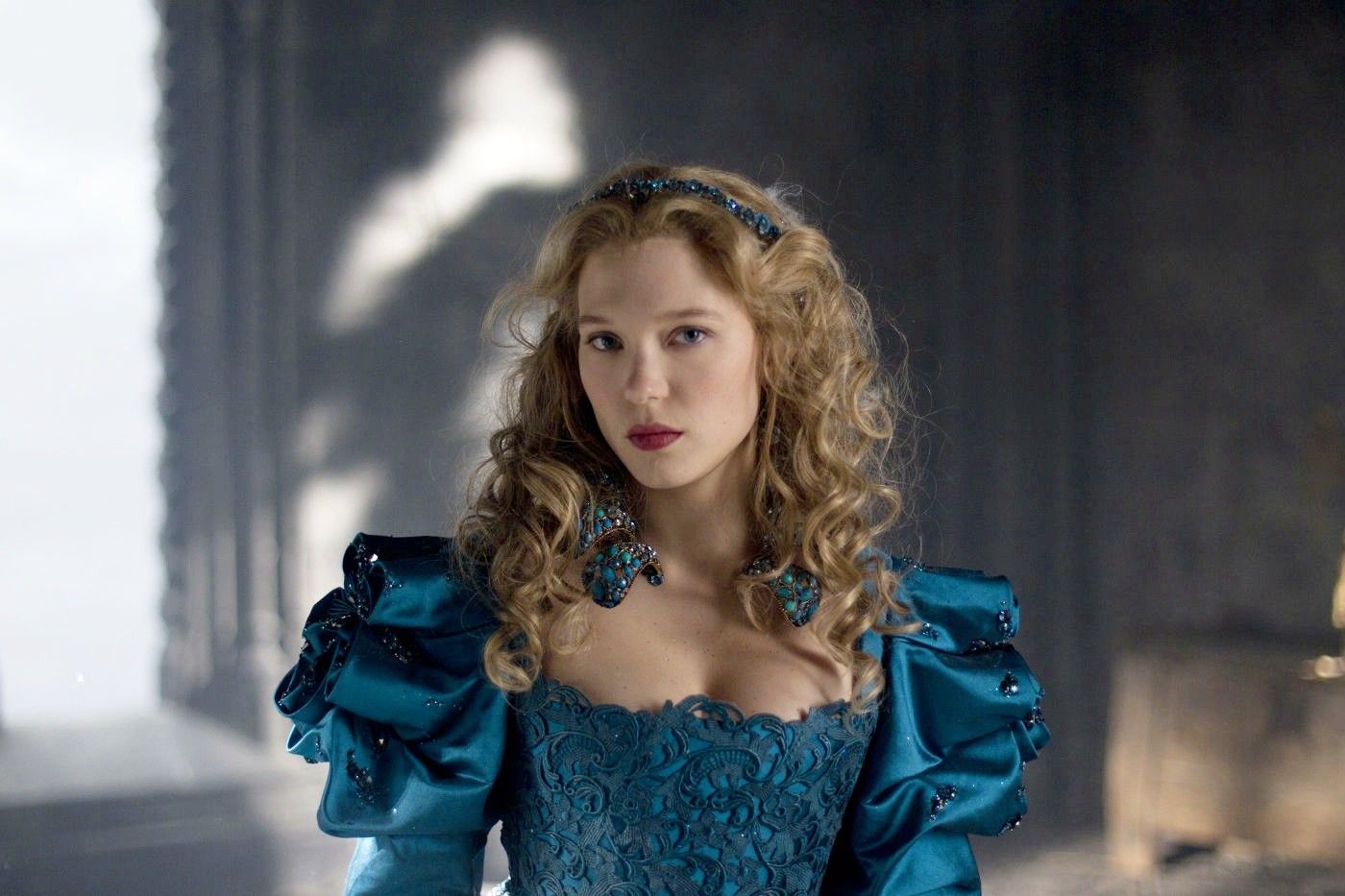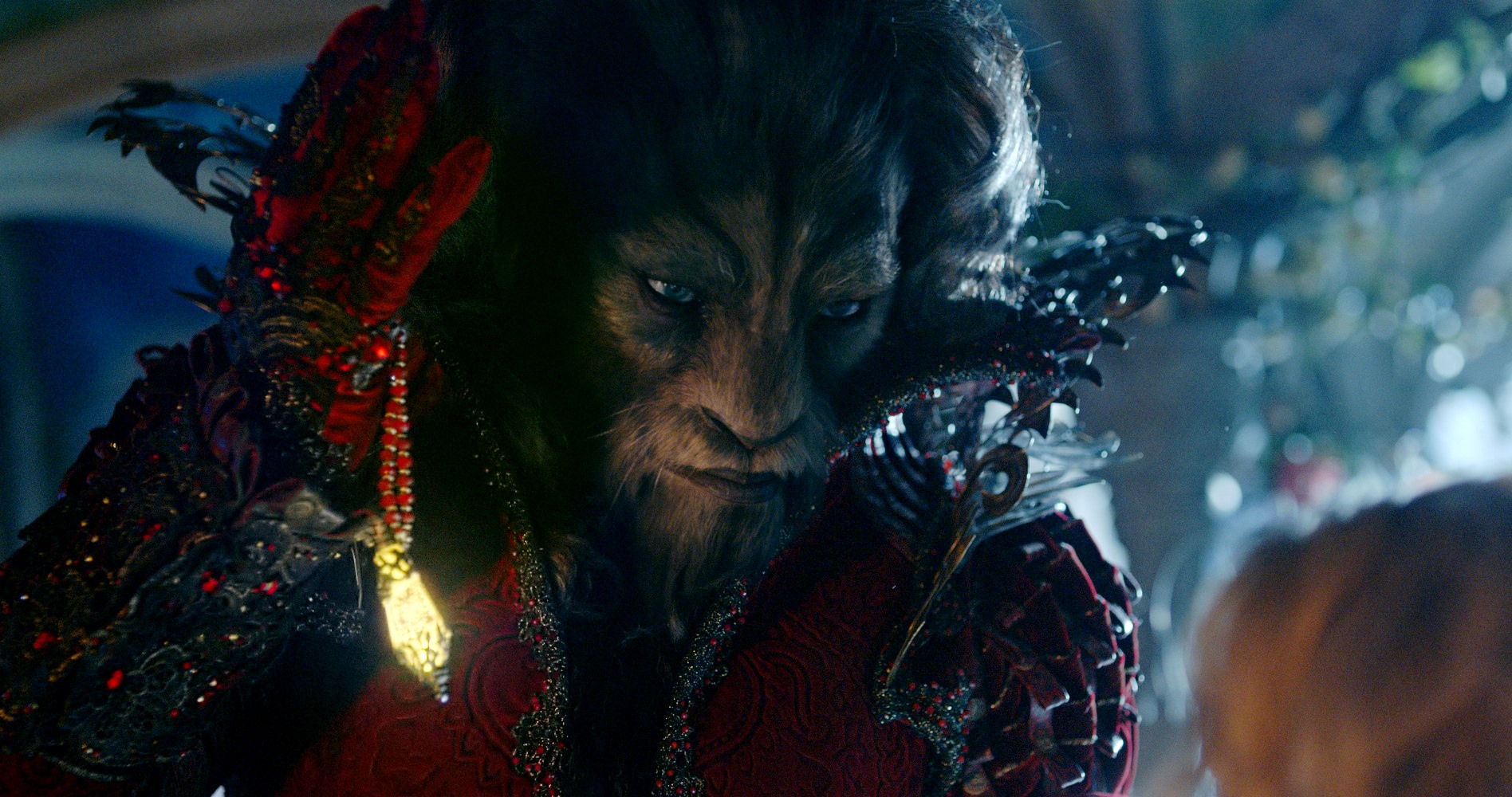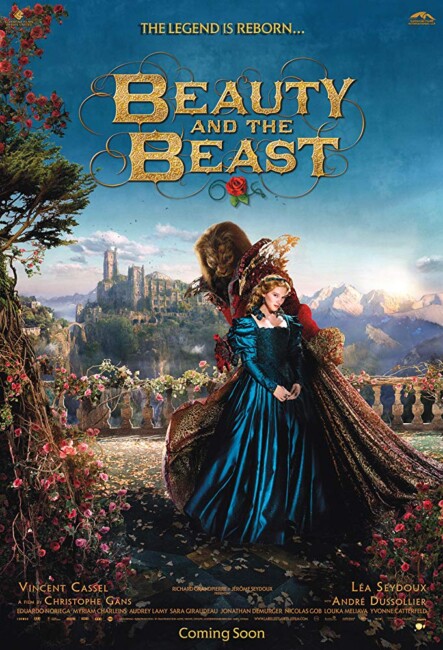(La Belle et la Bete)
France/Germany. 2014.
Crew
Director – Christophe Gans, Screenplay – Christophe Gans & Sandra Vo-Anh, Producer – Richard Grandpierre, Photography (3D) – Christophe Beaucarne, Music – Pierre Adenot, Visual Effects Supervisor – Louis Morin, Visual Effects – Modus FX (Supervisor – Martin Pelletier), Mokko Studio (Supervisor – Alain Lachance), Oblique FX (Supervisor – Alexandre LaFortune) & Mathieu Raynault, Special Effects Supervisor – Uli Nefzer, Creature Design – Patrick Tatopoulos, Production Design – Thierry Flamand. Production Company – Eskwad/TF1 Films Producion/Studio Babelsberg/120 Films/Canal+/Cine+/TF1/TMC/DFFF/Medienboard Berlin-Brandenburg/FFA/Centre National du Cinema et de l’Image Animee.
Cast
Lea Seydoux (Belle de Bofremon), Vincent Cassel (The Beast/The Prince), Andre Dussolier (The Merchant de Bofremon), Eduardo Noriega (Perducas), Myriam Charleins (Astrid), Audrey Lamy (Anne de Bofremon), Sara Giraudeau (Clotilde de Bofremon), Jonathan Demurger (Jean Baptiste de Bofremon), Nicolas Gob (Maxim de Bofremon), Louka Meliava (Tristan de Bofremon), Yvonne Catterfield (The Princess)
Plot
The merchant de Bofremon is ruined after three of his ships are sunken at sea. He and his three sons and three daughters are forced to abandon their villa and move to a cottage in the countryside. Only the youngest daughter Belle enjoys life there where she has the freedom to cultivate a garden. When news comes of the recovery of one of the ships, the merchant rides to investigate. The other daughters ask for lavish gifts but Belle only asks for a single rose for her garden. Arriving at the port, the merchant is forced to flee town pursued by his son Maxim’s debtors. With his horse wounded, he enters into a magical woods. He comes upon an abandoned castle where he finds food laid out for him and his horse healed. However, when he goes to take a rose for Belle the next morning, he is attacked by a savage beast. The beast demands the merchant stay in return for stealing one of his beloved roses, although relents to grant him one day to go and say goodbye to his family. Upon hearing what happened, Belle returns to the beast in her father’s place. There she forms a friendship with the fearsome but tender beast, learning the secret of how he was a man who was cursed with animal form for killing the fawn that was his beloved, a woodland nymph who changed between animal and human form. Her presence serves to open the beast’s heart to her.
French director Christophe Gans is a genre contributor of some interest. After working as a film critic, Gans made his directorial debut with the The Hotel of the Drowned segment of the H.P. Lovecraft anthology Necronomicon (1993). He made his full-length debut with the underrated adaptation of the manga Crying Freeman (1995). Other works followed with the historical monster movie Brotherhood of the Wolf (2001) and the reasonable hit of the videogame adaptation Silent Hill (2006), while he also produced Saint Ange (2004) for the then unknown Pascal Laugier.
Beauty and the Beast emerges after an eight year period of silence where Gans moved through a number of productions that failed to come off, including the sequel to Silent Hill, an adaptation of the ninjas vs supernatural videogame Onimusha and Fantomas, a remake of the classic silent serial about a super-thief.
Jeanne-Marie Leprince de Beaumont’s Beauty and the Beast (1756) is considered one the classic fairytales. It has been adapted to the screen numerous times (see below). Christophe Gans keeps largely to the classic telling of the tale, except for one or two minor details elaborating out the problems resulting from one of the brothers’ gambling debts. The major change is in the invention of the Beast’s backstory – how he was a prince of the lands, met and married a beautiful women who asked only that he do not kill the golden fawn, which he ignored only to find out that he had instead killed her – a woodland nymph who was a shapechanger – whereupon he was cursed with beast-like form by her father, the god of the forest.

Christophe Gans has obviously intended Beauty and the Beast as an entry in the series of dark and moody adult-intended adaptations of classic fairytales that we have seen in the early 2010s, beginning with Red Riding Hood (2011) and passing through the likes of Mirror Mirror (2012), Snow White and the Huntsman (2012), Hansel & Gretel: Witch Hunters (2013), Jack the Giant Slayer (2013), Maleficent (2014) and Cinderella (2015), as well as the tv series’ Grimm (2011-7) and Once Upon a Time (2011-8). During this period, Beauty and the Beast has also been incarnated in efforts such as Beastly (2011), which placed Beauty and the Beast in a high school setting, a tatty fantasy film Beauty and the Beast (2009) and the tv series Beauty and the Beast (2012-6).
Gans and his team of CGI artists and costumiers go to town and create an exquisitely dreamy fairytale world. The magical land reminds a good deal of the artistic and scenographic excess that Ridley Scott lavished on the amazing and underrated Legend (1985), which was one of the first dark, adult fairytales.
The fields and wild woods of the Beast’s magical kingdom glow with hyper-real beauty. The grounds are filled with the stunning architecture of fallen and overgrown buildings, statues of giants that lie half-buried in pools. Even the hallways of the castle and Beauty’s bedroom come overgrown with artfully decorous creepers. There are banquet tables over-spilling with food as though out of a classic painting, while Gans has borrowed a touch from Jean Cocteau and has the dining hall filled with magically self-lighting candles.

There are shots that make you cry out in amazement like the image of Lea Seydoux pursuing a deer through a forest carpeted with red roses. Or where the Beast pursues Lea Seydoux out onto the iced over lake and pounces on top of her, only for her to fall through the ice, followed by the breathtaking wide angle shot from under the ice as we see her sinking in a tiny nimbus of light before being snatched back up by the Beast.
The main problem with Beauty and the Beast is the CGI effects. There is nothing wrong with them per se and many of the shots creating the magical kingdom are stunning. It is just that the creature effects fail to convince. Perhaps this is a little in the way of Uncanny Valley but the scenes where we have a CGI-generated Beast only seem like you are looking at a CGI-generated creature as opposed to a character – not the sort of effect you get looking at say Weta’s Gollum in The Lord of the Rings films, their King Kong (2005) or the ape characters in the Planet of the Apes reboot series. There is the same effect when it comes to other supporting non-human creatures throughout such as Tadomi creatures or the giants that rise at the climax. Similarly, the pursuit of the golden fawn through the woods and perfectly laid out gardens is another of the film’s dreamily beautiful images, spoilt only by an obvious CGI animal.
Vincent Cassel is top-billed but his appearances as himself are largely kept to a handful of flashbacks and he disappears altogether when the motion-capture artists take over to create the digital Beast. Lea Seydoux, who one kept being reminded of with blue hair and seeing more intimate detail of her that one probably needed in the lesbian epic Blue is the Warmest Colour (2013), has a beatific loveliness as Beauty.

Other versions of Beauty and the Beast include:– several lost silent versions made variously in 1899, 1903, 1905, 1908, 1912, 1913 and 1922; Jean Cocteau’s classic version Beauty and the Beast (1946) with Jean Marais and Josette Day; the stodgy Technicolor adaptation Beauty and the Beast (1961) starring Mark Damon and Joyce Taylor; Beauty and the Beast (1976), a tv movie adaptation starring George C. Scott and Trish Van Devere; a Czech adaptation Beauty and the Beast (1979); a 1984 episode of Shelley Duval’s Faerie Tale Theater starring Klaus Kinski and Susan Sarandon and directed by Roger Vadim; the Cannon Movie Tales adaptation Beauty and the Beast (1987) with John Savage and Rebecca De Mornay; Beauty and the Beast (1991), the Disney animated adaptation; Beauty (2004) starring Martin Clunes and Sienna Guillory, a modernised retelling; Beauty and the Beast (2009) starring Estella Warren, which turned the fairytale into a cheap fantasy adventure; Beastly (2011) starring Alex Pettyfer and Vanessa Hudgens, which transplanted the fairytale into a modern high school setting; the tv movie Beauty and the Beast (2012) starring Ruith Bradleyl; Beauty and the Beast (2017). the live-action remake of the Disney film starring Emma Watson and Dan Stevens; and Belle (2021), an anime version set in Virtual Reality. Beauty and the Beast (1987-90) was a fantastical contemporary urban tv series loosely based on the fairy-tale, starring Ron Perlman and Linda Hamilton, and was later remade as Beauty and the Beast (2012-6) starring Kristin Kreuk and Jay Ryan.
(Nominee for Best Director (Christophe Gans), Best Cinematography and Best Production Design at this site’s Best of 2014 Awards).
Trailer here


